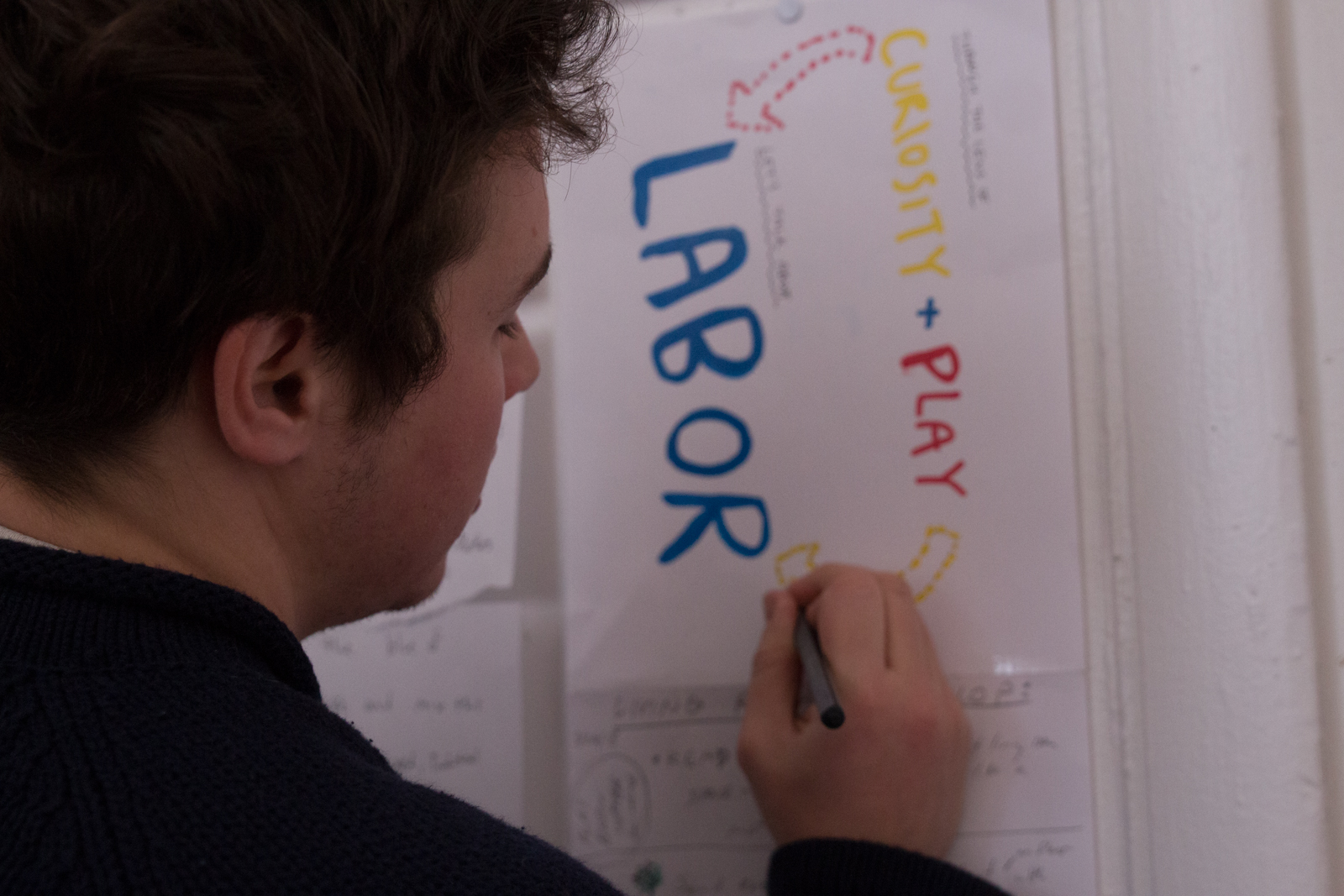Luan Joy Sherman is a queer, trans masc artist living and working in Brooklyn, NY. He works with video, embroidery, photography, sculpture, performance, and sound to explore trans identity, queer bodies, autoethnography, and self-care. Please join Sherman this Thursday March 29th, 6-8p at SPACE 538 Congress St. for the workshop Making Space: Queer Modality that will explore access, identity, and place, through a queer lens in the context of contemporary politics and self-care practices. Sherman will unpack and examine how queer modality has shaped a broader sense of self, access to resources and privacy, and approach to self-care and intimacy. The workshop will include group discussion about access, identity, and place. Participants will engage in interactive exercises that use a queer lens to explore documentation, capacity, and body regulation. Flyers will be given out that cover the process of changing personal documentation, designed for use in any step of the process.
**This workshop is designed for LGBTQIA identifying people and all participants should be mindful of their use of language and respect for difference and personal boundaries. This workshop is free and open to the public.**
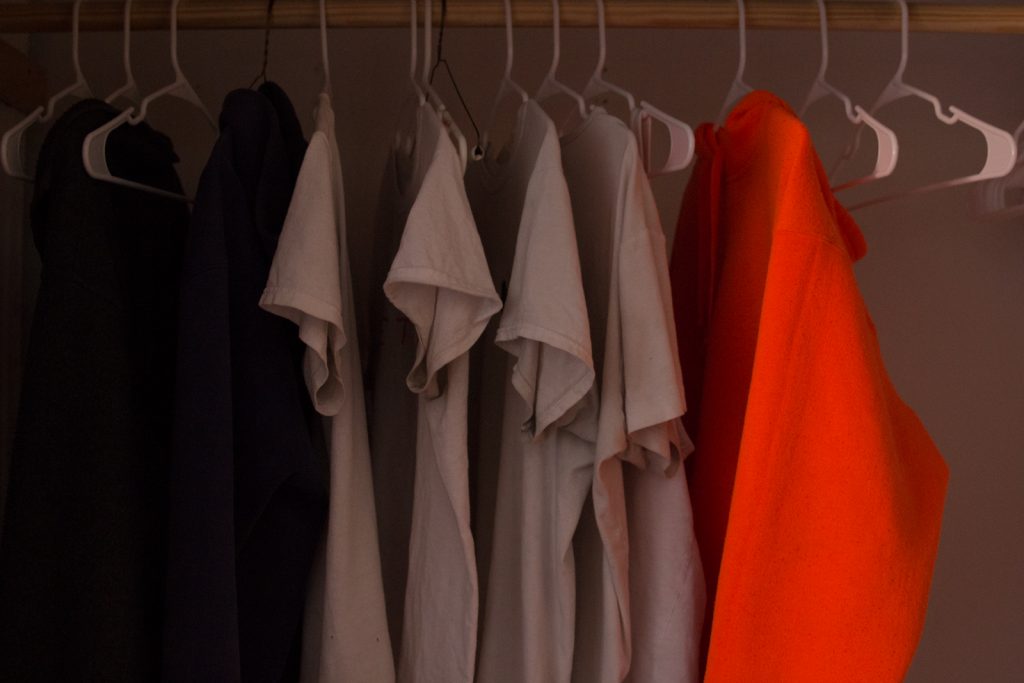
The following is a transcript form an interview conducted by Martha Schnee at SPACE in Portland, Maine.
Let’s start with introducing yourself and describe your practice and your work a little bit?
My name’s Luan Joy Sherman. I am an artist and facilitator and writer sometimes. I’m here at SPACE and that’s cool. Everything feels very transitional right now. So I think right now my practice is about learning how to be okay with uncertainty and lean in to the experience of not knowing what’s going on or not knowing what I’m doing. It’s been, for the last two years, a lot about my experience transitioning and queer bodies and specifically my body, and my experiences of medical transition which involved a lot of surgical complications and other health stuff. So it was really self-reflective and autoethnographic. Doing work about yourself. Recently, I think it came to a head for me to do work that is inherently about queerness without being objectively or obviously about queerness. So that’s where I feel like I am now.
You’re about to start your sculpture MFA at School of the Art Institute of Chicago. I know that you work across many media, I’m curious how you fell into sculpture as that focus?
I applied to the sculpture program because I discovered that my practice is really about building, so everything I do is about how to construct something and how to create a foundation for things, and it’s a lot of excavation too. Whenever I think about the words I’m using to describe my practice it’s these physical things that belongs in sculpture whether it’s writing or a lot of personal excavation. I’m excited to be able to actually build things with the program. Big, heavy, annoying things.
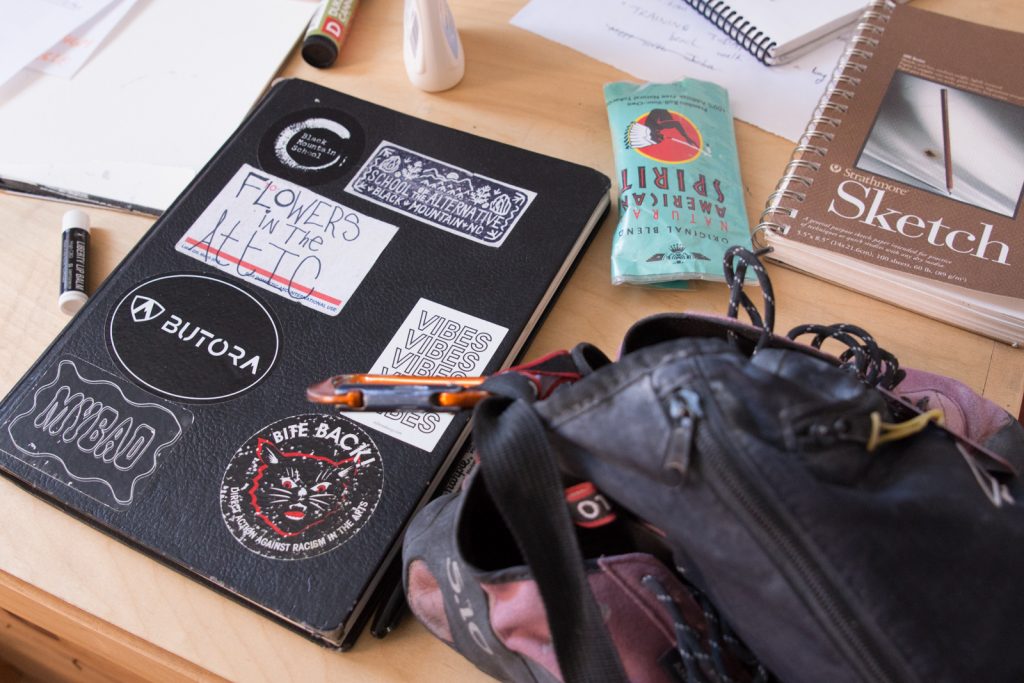
One of my specific questions is about rocks. I just want to hear you talk about rocks, because I’ve never heard someone so passionately exclaim about rocks. Tell me about rocks. Should we just touch them?
I gathered all these rocks yesterday, I was at Eastern Prom. There’s this one stretch that’s probably fifty feet in total, I spent an hour on that stretch. Crawling slowly through all of them and over and reaching in, this one came from deep between a bunch of them. I got really into rock climbing this year, indoor rock climbing. I’ve recently come to terms with my love for rocks as a person. This one has a nice little thumb here.
This is a very holdable rock.
Very holdable indeed. Yesterday I had a breakthrough in why this is such an obsession for me, and I imagine it’s more complex than just this, but because I grew up here, for at least four years of my life, we spent a lot of time at the beach and we were always around, just walking around in these spaces. So I developed a relationship with the ocean and with beaches that are not about the water. Especially Maine, how insanely cold it is, it’s just so uninhabitable in every way. It’s not about the water at all. So the beach doesn’t feel like this thing that’s about the idea of a beach, it’s about what a beach actually is. And that’s what this is about, I think, as a queer person also not being ok with having any kind of a bathing suit. There was no solution for that for me, there still kind of isn’t. Being outside people stare because I have these big giant scars, like seven inches on either side. It’s not meant for queer bodies in a lot of ways, and so I spent all this time as a kid exploring the margins of this environment, and really becoming obsessed with rocks and tide pools and all that stuff.

So it’s all coming back through.
Yeah it comes full circle. It’s not an attractive setting for anyone either. The whole thing is, it’s a facade, and it’s fake. People spend, I don’t know anyone who does this, but I suppose people do spend months preparing for the beach, and then in reality it’s this thing that’s wholly disappointing.
What drew you to Maine?
Well, I was born in Portland. Maine Medical, that’s the hospital I was born in. While I’m here I want to visit there. We lived in Springvale for a minute, after I was born in Portland we lived in Springvale. And then we lived in Kennebunk for the rest of the time I was here and then we moved away when I was four or five. In Kennebunk, I was being babysat with my brother by this person one day and I pushed out the screen of one of the windows on our second floor above the garage and fell onto the driveway, like two stories from this window. It was the most bizarre, miraculous event because I had a small crack in my skull and that was the only injury. I’ve had this idea and fantasy of returning to this place at some point, and then visiting that house and meeting the people who live there currently, which is what I’m going to do.
Do you want to describe your wall practice and your studio practice?
I have tried to ease back into drawing because it feels like something I removed myself from in undergrad, getting really into conceptual work and there being this especially heavy, dogmatic approach. I think with everything that I make I have this really intense- everything feels like it has to be important, it needs to exist. And if it doesn’t need to exist, then I don’t need to make it. So a lot of this I guess is drawing now. It’s a lot of writing. It’s a lot of making. I have this urge at the beginning of studio sessions to just do something, and begin studio sessions with something physical, like skateboarding in my room, or pretending to be a table, which I did the other night, or this ab roller thing. Just doing something that feels like, ok.
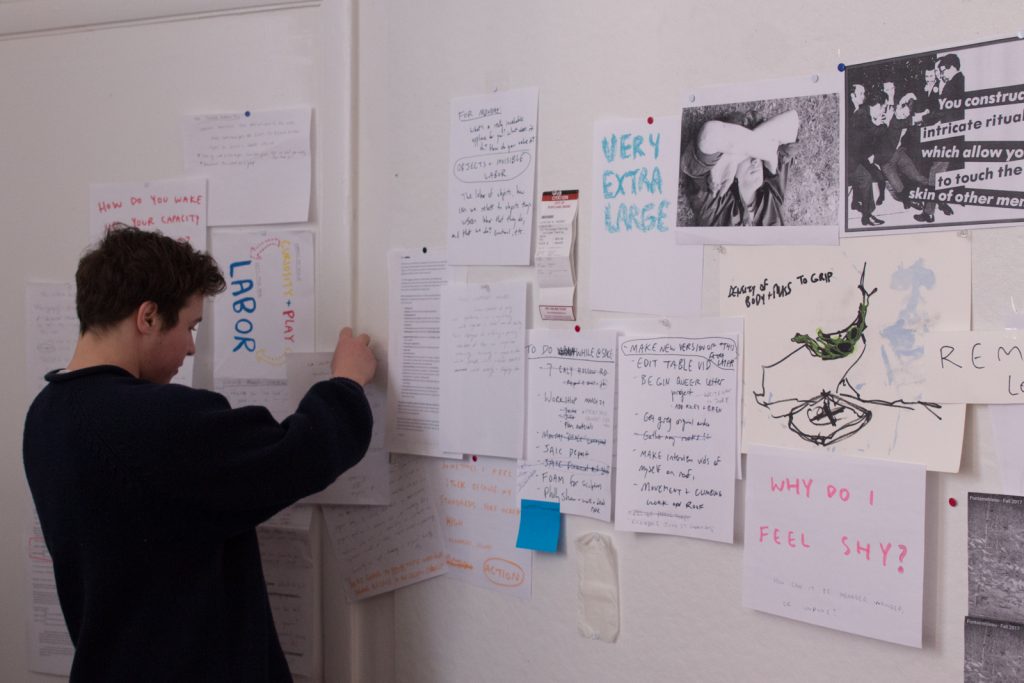
So we have this wall of so much brilliance on it, do you want to just pick a couple things to read?
Yes, this one I’m excited about that I wrote today. It says:
Our trauma lives on the inside and the outside
It takes up space, it lives, it’s hungry and requires attention
I’ve been reading this book called True Love by Thich Nhat Hanh, he talks about caring for your pain like a mother to a child, and speaking to yourself as a mother to this pain. It’s so beautiful.
Do you want to talk for a second about the workshop you’re planning as part of your residency?
Objects and invisible labor is something I think I want to talk about. I think about the way that we ignore the labor that takes place to support our existence. And we do that in ourselves and we do that in other people. We ignore the expense that emotional labor takes, we ignore the expense of intellectual labor. Physical labor is a thing you can actually… Physical pain versus emotional pain. You can see it; you can talk about it because it has a location. But emotional labor is non-local, it’s just this thing that floods your body. I have this table that I brought with me that has legs that collapse individually, one at a time, I spent awhile on the floor trying to keep level and imagining people needing it to be level, so my work was necessary in order for it to function. Especially thinking about tables and what they signify, I’ve been doing a lot of excavation with that stuff. The thing for me about creating, building in that idea I was talking about earlier with sculpture, is also what you can do as a responsible facilitator to build a space that can be inhabited in a way that you’re asking people to inhabit it. Creating a thing that can be useful for people, because ultimately it’s about what other people are getting from it. The point is for it not to be about me. For this workshop on March 29th, the title is Making Space: Queer Modality and the idea being allowing space for conversation on how queerness impacts your experience with three topics: access, identity, and place. We’ll do a lot of discussion around what that means as queer people. Also I want to do some movement exercises to physical self-care as a group, especially right now, thinking a lot about how important it is for community to be valued and to be recognized as a thing that improves our lives and is necessary.
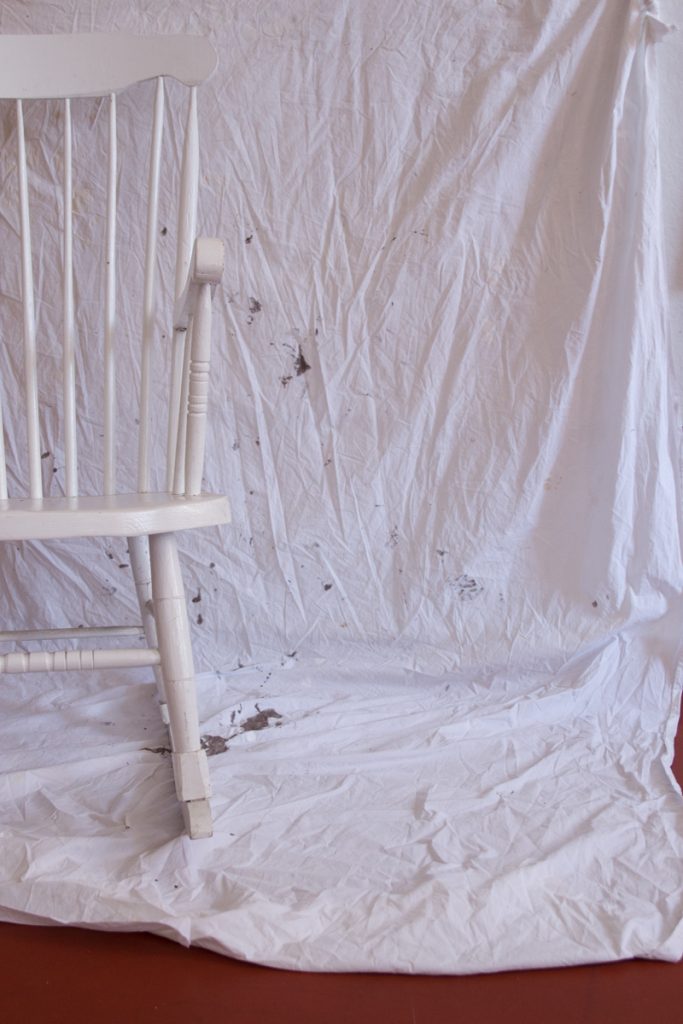
I was looking at the objects that you’ve created, or manipulated, and I’m curious how you chose some of these objects. You have shirts and blankets and floor mats.
The blankets definitely as a thing that is malleable, because the photo blankets I’ve done recently are of trans masc bodies, exclusively. It was this thing that I could create as a big acknowledgement of something that I wanted and something that I idealized. So to put it on a platform that’s decorative and idyllic and beautiful that’s one element of it because it’s kind of a decorative item. Then also the blankets themselves are malleable things you can wrap around yourself. I made one of my own body last year and have done performances with it where I’m wearing my own blanket. That part of it was really healing, I’ve had experiences with other trans guys whose images I’ve used and they sent me images and I used them for this work and it was, for them to see that work in public, to see their bodies in public, to see people around it and have it be normalized and also elevated in this way was really healing for people. So I think blankets in terms of intimacy is a big thing. What is leisure? I think leisure for me has to be- I have to be intentional about it because it’s really hard to do. Allowing myself to do something that is strictly fun and not about work and makes me feel like I can recharge.
Yay! Leisure, good way to end. Thank you for talking with me.
This was so rad, thank you.

